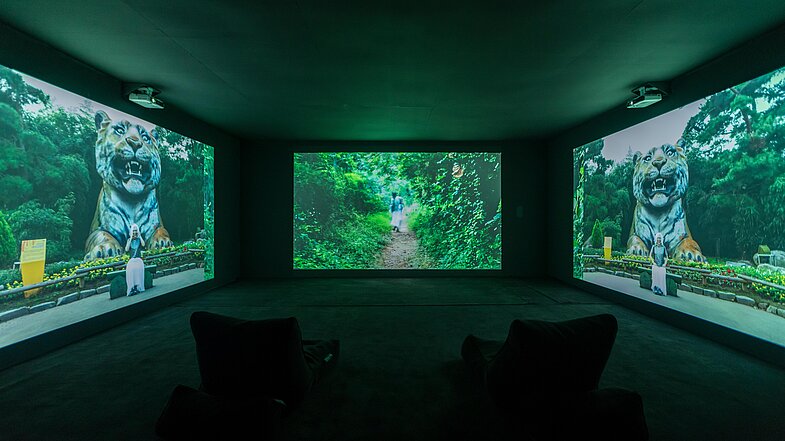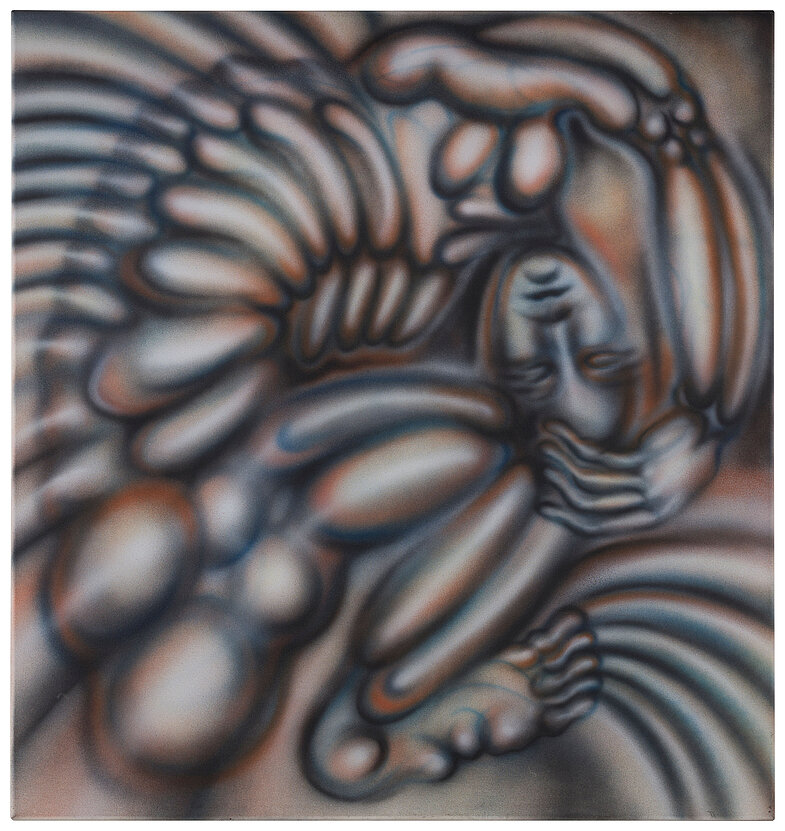
Do structural problems only become visible when those very structures start to crack? For whom are glass ceilings transparent? Who stares at concrete while looking up? Based on the controversial idea that infrastructures only become visible when they break, the group exhibition Invisible Until It‘s Broken brings together eight spatially expansive installations.
In the works of these artists, the boundaries between private and political, between the individual and the collective, become blurred. They demand our involvement as viewers precisely because of their autobiographical references. With their poetic-political, sometimes playfully humorous perspectives, the artists put their fingers right in the wound. Cracks in social and material infrastructures become palpable. Most of the works are shown for the first time in Germany as part of the exhibition Invisible Until It‘s Broken.



The Super 8 film titled "This Makes Me Want to Predict the Past" portrays a group of young people at Munich's Olympia shopping center, where nine people were murdered, five others shot and many seriously injured during a racist attack in 2016.
The camera in the film follows two people in their everyday explorations of the mall as they address their dreams and hopes, but also fears and nightmares. Again and again fiction and reality are mixed, scenes from the 1982 play Theaterstück Düşler Ülkesi are taken up and different time levels are cross-faded. Düşler Ülkesi (engl. Land of Dreams) refers to a children's and youth theater play of the same name by Erman Okay, which premiered in Munich in 1982. In the play amateur actors acted out everyday scenes from the lives of so-called "guest workers," also addressing unfulfilled longings, broken promises, prejudices and misunderstandings. The project was also a pioneering project in which young people of different origins were brought together in a joint process to build mutual understanding. The premiere of the play was overshadowed by a right-wing fascist bomb threat in Munich against the theater.
www.instagram.com/canabilmei

Yun Choi’s artistic practice looks into the absurd emotional conflict caused by the overlapping and lagging timelines of a rapidly updating society. The complex sensations of alienation, awkwardness and attachment are essential aspects of her interdisciplinary work. Tinkering with contemporary (digital) byproducts and residues produced from those sensations, she uses and explores various methods, such as mimicking, accumulating and propagating. With her video installation she invites us to dissolve the boundaries of conventional colonial perspectives by eliciting feelings of disorientation, shapeshifting into multibody beings and inviting sincere superstitious beliefs.

Rajyashri Goody’s artistic practice highlights how Dalit identity is being reclaimed and reinvented today through acts of everyday resistance, such as going to school, drinking water from public wells, falling in love, sharing a meal, rejecting Hinduism or converting to other religions. Dalit people have been treated as “untouchable” and “impure” for thousands of years. Many are still denied basic rights to land, food, water and literacy. Goody is interested in how the caste system has been challenged by her family and larger community and the cultivation of self-respect, confidence and dignity as a personal and collective practice. As part of her installation the floor is covered in paper pulp – originally a discriminatory Hindu law book called the Manusmriti.

Veronika Hapchenko studied stage design at the National University of Cinema and Television in Kyiv before moving to Poland to pursue an MFA in painting from the Cracow Academy of Fine Art. Upon her graduation in 2021, she received distinctions in the 45th Painting Biennale "Bielska Jesień" and 19th Hestia Artistic Journey Awards. Her works are currently on view at Muzeum Sztuki in Łódź as part of the exhibition "Citizens of the Cosmos". Embracing painting and object making, Hapchenko’s practice often traces legends and taboos surrounding revolutionary artists and political gurus to deconstruct and rethink the cultural tropes of the former USSR, which oscillated between esotericism and militarism. Veronika Hapchenko lives and works in Krakow. Veronika Hapchenko is currently working on a new series of paintings, which will be shown for the first time.
www.instagram.com/nikahapchenko
www.importexport.art/exhibitions/13-false-door-by-veronika-hapchenko/overview

Dampbusters centres around the work of Cathy McCormack, a housing and anti-poverty activist from Easterhouse, Glasgow, who fought to raise awareness around the effects of damp housing on the body. Alongside Cathy’s story weaves other examples of communities that have fought and are fighting for access to space in the city. Take Root, a women’s self build group in nineties Glasgow, Maryhill Integration Network, a community centre for people in the asylum system and Slaghammers, a feminist metalwork group, who are finally moving into a new space.

Fountain (Bad Landlord) consists of a concealed irrigation system installed in the ceiling, through which water drips into several ceramic buckets arranged around the floor - mimicking the appearance of a leaky ceiling and a temporary solution. By intervening directly in the existing architecture of the exhibition space, Fountain (Bad Landlord) involves the institution itself in the question of precarity. It points to crises of real-estate within the world of art exhibitions, as well as recalling, for many, personal crises of rented housing. The ceramic buckets that catch the drips play a role simultaneously as art objects, fulfilling their function to the art exhibition space, as well as water receptacles, fulfilling their function as real buckets. Their materiality suggests the ossification of temporary solutions, as crises management becomes the norm.

In the game-installation Socks Off! Pennie Key creates an arena where the visitors can play sock wrestling. The aim of the game is to remove the opponent’s socks while keeping yours on. Pennie Key used to play this game while she was working as a model at fetish festivals. For this installation she has built a sterile black-and-white environment, with disproportionately strict and extreme rules. Aiming to create an environment empty of hints, for a game that is supposed to be fun, and played between kids and foot fetishists alike.

In Selma Selman’s art works the ultimate aim is to protect and enable female bodies and enact a cross-scalar approach to collective self-emancipation of oppressed women: „In this project, I am serving as a lens that focuses on the concrete and significant details of my mother‘s past, possible and actualized dreams. I worked together with my mother, reconstructing the memories of her desired rooms from the childhood that she never experienced. My mother‘s childhood was lost due to child marriage at age 13. Her dream was to have a girl’s room. The room was created during an interview with my mother. I drew her room according to real and fictive memories of unrealized dreams and then made a 3D print. The title A Pink Room of Her Own refers to Virginia Woolf‘s A Room of One‘s Own. Although my mom is not writing from the same personal experiences - she personally experiences and desires the same room to live, feel intimacy and freedom.“ (Selma Selman)